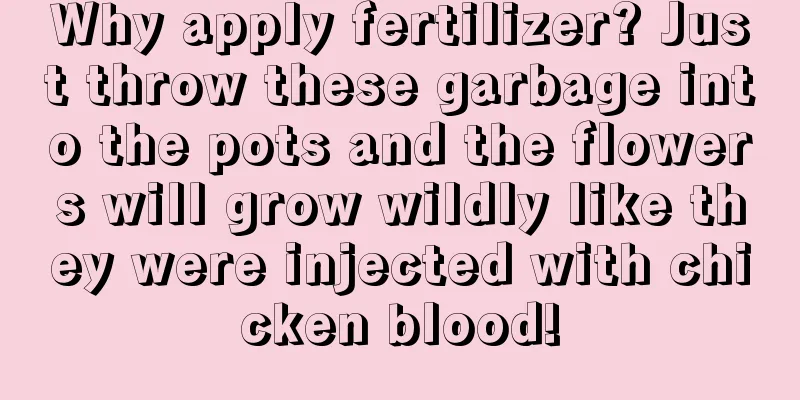Why apply fertilizer? Just throw these garbage into the pots and the flowers will grow wildly like they were injected with chicken blood!

Apple peelApple is a fruit that can be eaten all year round, and the peels can be used to grow flowers anytime and anywhere. Steps:1. Prepare an empty flower pot and spread 3-5 cm of garden soil on the bottom of the pot. 2. Spread the apple peels evenly on the soil. 3. Cover the surface of the apple peel with a layer of nutrient soil, about 3-5cm thick. Then lay another layer of peel, alternating layers, and so on, for about 7 layers. Finally, cover the surface of the flower pot with a layer of soil. 4. Sprinkle some water in to soak the soil. Wrap the flower pot with a plastic bag and place it in the sun. After about 2-3 months, the apple peel will be completely rotten and can be mixed with soil to grow flowers! Flower cultivation recommendation:At this time, the soil is very nutritious and acidic. Stir it evenly and then add other soil. It is perfect for growing gardenias and jasmine! Peanut ShellsMany flower lovers use peanut shells to pad the bottom of the pot to make the soil breathable and avoid water accumulation. In fact, peanut shells have greater uses and are a rare natural fertilizer. Steps:Method 1: Sprinkle the surface of the basin and add potassium fertilizer 1. The easiest way to turn peanut shells into fertilizer is to burn them. 2. The peanut shells after burning are natural potassium fertilizers and can be used directly after being crushed. Flower cultivation recommendation:The burned peanut shells contain a large amount of potassium, which is very suitable for the maintenance of plants with long flowering periods and many flowers, such as roses, camellias, etc. You can directly sprinkle them on the soil around the flowerpots, and the flowers will bloom more and more brightly. Method 2: Mix with soil to prevent root rot1. Put the peanut shells into a plastic bag and crush them. Then add enough water to soak the peanut shells, seal it and leave it for two hours. 2. Drain the water from the bag and reseal it. You can use a rope or rubber band to tighten the bag and place it in the sun to dry! sun! sun! 3. After about a month, the peanut shells will become mature and turn black. Flower cultivation recommendation:Composted peanut shells are good nitrogen fertilizers and are also highly breathable. Mixed into the soil, it is very suitable for caring for plants that are afraid of root rot, such as money trees and orchids. Grapefruit peelIt’s the season for eating grapefruit again. Many flower lovers use grapefruit peel to deodorize and freshen the air. In fact, it can be used to grow flowers~ 1. Cut the grapefruit peel into small pieces. 2. Spread a layer of soil on the bottom of the plastic bottle, about 3-5cm thick, then evenly spread a layer of grapefruit peel, and then spread a layer of soil. Repeat this process until it reaches the position shown in the picture, and finally cover it with another layer of soil. 3. Open the bottle cap every once in a while to let some air in to prevent the plastic bottle from exploding. Be careful not to add water, as it will create odor. The grapefruit peel will be fermented in about a month. Flower cultivation recommendation:The fermented grapefruit peel nutrient soil is an excellent phosphorus fertilizer, which is suitable for maintaining plants such as green radish and spider plant, so that the plants can sprout more new roots and buds and grow luxuriantly. eggshellFlower lovers all know that eggshells are good fertilizers for growing flowers, so they often place eggshells directly on the surface of flower pots. In fact, this practice is wrong and will attract insects. So what to do? Steps:1. Collect the eggshells, wash them and dry them. 2. Use a hammer to smash them into pieces, the smaller the pieces, the better. 3. Mix the crushed eggshells into the soil and stir back and forth to mix evenly. 4. Seal the flower pot with a plastic bag and leave it for 5-7 days. Flower cultivation recommendation:Eggshells contain a lot of calcium and trace elements, which are very beneficial to the growth of branches and make them tougher. They are suitable for maintaining geraniums, asparagus ferns, etc. Orange peelTangerine peels and orange peels can not only be used to eliminate odors, but are also very effective for growing flowers and are very easy to use. Steps:1. Prepare empty bottles and water, and chop the orange peel. 2. Mix water, peel and brown sugar in the ratio of 10:3:1 and seal in a plastic bottle. 3. Place the plastic bottles in the sun and they will be fully decomposed in about 2-3 months. Flower cultivation recommendation:Composted orange peel contains a large amount of potassium, which can make the flowers of flowering plants more colorful and full, and is suitable for the maintenance of Kalanchoe, Daphne odora, etc. Mix the decomposed fertilizer water and clean water in a ratio of 1:50 and pour it directly on the soil. |
<<: Can’t you keep the succulents alive in autumn? See if you have fallen for these tricks!
Recommend
The difference between Monstera and Dripping Guanyin
1. Difference of blades The leaves of Monstera ar...
If you don’t check, all your succulents will die!
Daily management of succulents (from summer to au...
Can “Banyan Tree” also be used as a potted plant? Of course, it is also very easy to raise, and it looks very impressive when placed at home.
Did you know that banyan trees can actually be pl...
Does Zhanghongying Bougainvillea bloom frequently?
Zhanghongying is a classic variety of Bougainvill...
Causes and treatments for yellow leaves of red tassel flower
1. Temperature is too low Reason: The red tassel ...
When to repot plum blossoms
1. When to change the pot The plum blossom season...
How to water and fertilize Mimosa
How to water mimosa Mimosa is a tropical plant th...
How to grow Echeveria yunnanensis well
Growing conditions of Echeveria yunnanensis Echev...
How to water Kalanchoe
1. Watering principles (1) It prefers dryness to ...
How to prune cherry trees? Pruning time and technique diagram
Cherry tree pruning time Cherry trees can be prun...
When is the best time to plant Moringa?
Moringa sowing time Moringa, also known as drumst...
The Growth of Ji Longyue Laozhu
Step 1: Buds of Jilongyue After a period of care,...
Cultivation methods and precautions of Gleditsia sinensis
1. Maintenance methods 1. Soil: There are no requ...
Can taro be grown hydroponically? Is it better to grow it hydroponically or directly in the soil?
Can taro be grown hydroponically? Taro can be gro...
Cultivation methods and precautions of small-leaf gardenia
1. Sunlight Small-leaf gardenia is suitable for g...









